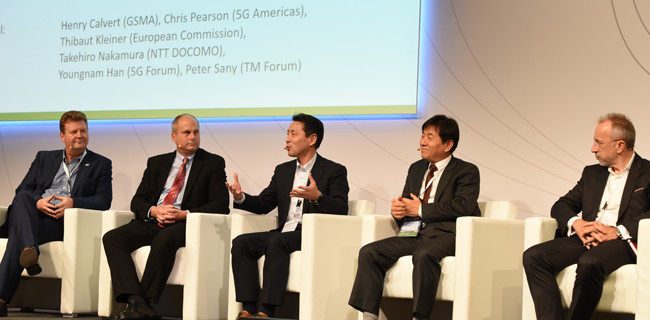 |
By Michele Zarri, Technical Director – Networks, GSMA |
GSMA’s Network 2020 programme was invited to speak at the recent NGMN conference on ‘5G: Status of Demand and Delivery’ in Frankfurt. The conference brought the industry together to discuss what 5G is, and to explore use cases and drivers with the aim of clarifying the path to 5G.
Key themes and technologies were discussed to bring a harmonised approach to delivery including network slicing as a technical enabler to serve all use cases with the same infrastructure. The ITU-R triangle was widely used to illustrate the expected portfolio of services that 5G will make available and how they exploit the enhanced data rates, low latency and support of massive IoT capabilities provided by the system.
New vertical markets
While enhanced mobile broadband was indicated by both Operators and Vendors as a key use case to fuel the deployment of 5G there was also further inspiration from new vertical markets. Some vertical markets, IoT in particular, may be too broad to be captured in a single set of functional requirements. However, a strong and tangible example of what is expected from 5G in terms of functionality came from the automotive industry with Audi, BMW Group and Continental representing the 5GAA (5G Automotive Association). The presentation looked at a new definition of mobile services and the next era of automotive innovation in the era of cloud, data, and business model innovation.
| Highlight – automotive industry presented their vision of what their expectation on 5G is:
• Connectivity everywhere, whatever the carrier, • Ultra reliable, • Low latency for mission critical messages (when accident occurs, sensors), • Licensed spectrum, with quality of service as a driver, • National and international roaming, with seamless roam, low latency and broad coverage. |
Spectrum allocation
Another key topic for 5G is the spectrum allocation, and harmonisation across the industry and worldwide. Most Operators declared their intention to start deployments below 6GHz, however we heard during the conference that it would be unlikely that a globally harmonised band could be selected (as an example some mentioned 700MHz as a potential frequency, although this band is already used in the US). The most popular spectrum band is 3.2 to 3.6GHz, which is not available in countries such as Japan.
Relating to the use of millimetre wave frequencies 28 GHz was indicated by most as the likely band of choice. Samsung also presented some lab tests performed at 60 GHz, a band already used by 802.11ad (WiGig) compliant equipment. 5G will be deployed in these frequencies at a later stage, most likely considering the small footprint of a cell operating at such high frequency, for special use cases like broadband hotspot or specific industry needs.
Henry Calvert, Head of the Network 2020 programme highlighted the role GSMA will play in helping Operators to obtain sufficient amount of spectrum and requested the UN sustainable development goals of connecting the unconnected were taken into account while developing the 5G system.
Technology driving 5G
In terms of technologies, the hot topics were virtualisation, with a focus on Network Slicing and Cloud based architecture. Most of the demonstrations in the exhibition area were showcasing these technologies.
Two further specific and interesting areas were debated, security and testing/proof of concept:
- Virtualisation and security, raised a key question on how to ensure maximum security with network slicing, virtualisation and cloud based architecture. As an example, how would it be best to execute lawful intercept when the functions are spread across multiple physical locations in a country, or even different countries? How could we ensure the integrity of a virtualised network? It’s not only the device and its intrinsic authentication (SIM) but also ensuring isolation of the sliced services in the device as well in the network. There was not much discussion on moving away from the SIM.
- Proof of Concept and sharing information on trials and experience on 5G deployment was highlighted as a possible cooperation area between all the NGMN members.
Open source and IPR also featured in the conference programme: the main debate was on what the percentage of IPR cost in a product supporting 5G is likely to be. The prevailing opinion was that it should not be more than 2.5% of the total cost, however the sheer number of “essential IPRs” expected to be used in 5G devices led some companies to believe that the percentage could potentially be as high as 30%. The panel agreed that there is a need for further debate on how to address the open source IPRs, and how to best engage with the open source community.
The road to 5G
It is clear that 5G is quite different from its predecessors. More than a new generation of technologies, 5G denotes a new era in which connectivity will become very fluid and very flexible. Networks will adapt to the application, rather than the other way round. Performance will be tailored precisely to the needs of the user and as a result the industry will need to continue to work together to share learning from use cases.
